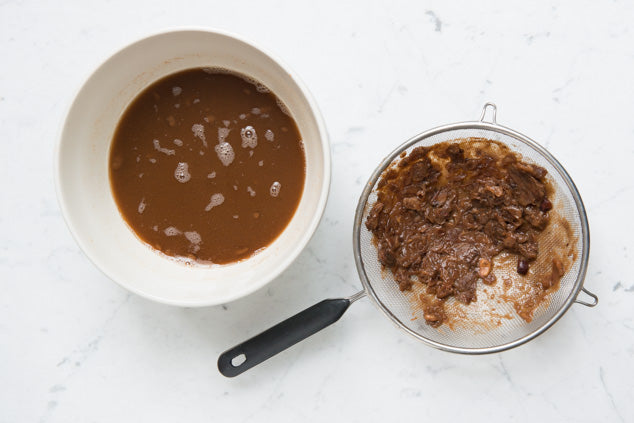
A Guide To Tamarind Paste And Tamarind Water
by Nicola Lando
-
20 minutes prep time
-
5 minutes cook time
-
Easy

Tamarind is a fruit related to peanuts and chickpeas. The brown-red fleshy pulp has a sticky, date-like consistency with distinctively tart flavour and sweet date aroma. The pods grow on trees which are native to tropical Africa, but are now also cultivated around the world in tropical climates such as India and Central America.
What is tamarind pulp?
Tamarind pulp is made from the citrussy flesh inside the tamarind pod - which grow on trees like the image above.
What is tamarind paste?
Tamarind paste is made by diluting tamarind pulp with water, into a pre-mixed solution ready for cooking. The amount the tamarind pulp is diluted varies between brands, so when cooking from a recipe add the paste slowly and taste as you go because the chef may be using a different brand. It is also known as tamarind concentrate or ‘cooking tamarind’ and is packaged in small plastic tubs similar to peanut butter.
Should I use tamarind paste or tamarind pulp?
Tamarind pulp is rarely used in cooking unless diluted. Instead it is commonly used to make tamarind water before adding it to a recipe. Tamarind paste is much more convenient and quicker to use as you can easily spoon it from the jar directly into your dish. However, if tamarind is the main flavour in your dish, homemade tamarind water has a much fresher taste.
What is tamarind used for?
Tamarind is used throughout southeast Asia in curries, Indian cuisine and even in a Mexican drink called Agua de Tamarindo. Try cooking with tamarind in these recipes:
- Indian tamarind recipe: Goan Roast Cauliflower & Green Bean Curry
- Iranian tamarind recipe: Yasmin Khan's Bandari Fishcakes with a Tamarind and Date Sauce
- Thai tamarind recipes:
- Nam Phrik Kapi - an all-purpose Thai sauce
- Our Perfect Pad Thai Recipe
- Seabass with Tamarind and Chilli
What is tamarind water and how to make it?
Tamarind water is made by soaking tamarind pulp in boiling water before straining through a sieve and storing the liquid. Many recipe books will direct you to make your own tamarind water, to ensure that you are using the same concentration of tamarind as the chef. Read below to learn how to make it step-by-step.
Frequently Asked Questions
Are tamarind paste and tamarind concentrate the same thing?
Yes. Normally tamarind paste and tamarind concentrate are the same product. We sell a great tamarind paste here.
What can I use instead of tamarind paste?
Some good alternatives to tamarind paste are pomegranate molasses, amchoor powder, rice vinegar or simply a blend of lime juice and brown sugar.
If you like cooking with tamarind, shop for southeast Asian ingredients here
Tamarind Water Recipe

Tamarind water ingredients Serves: 12
- 100g tamarind pulp
- 600ml boiling water
Method for making tamarind water
- Pour boiling water over the tamarind pulp, and leave to soak for 20 minutes. Break the pulp up with a fork, and strain the mixture into a bowl using a sieve. Press as much pulp through as possible using a spoon, and scrape any tamarind puree from the underside of the sieve into the bowl.
- The tamarind water will keep in the fridge for up to a week, or can be frozen. If freezing, pour into an ice cube tray for easy-to-use portions.

About the author
Nicola is co-founder and CEO at Sous Chef. She has worked in food for over ten years.
Nicola first explored cooking as a career when training at Leiths, before spending the next decade in Finance. However... after a stage as a chef at a London Michelin-starred restaurant, Nicola saw the incredible ingredients available only to chefs. And wanted access to them herself. So Sous Chef was born.
Today, Nicola is ingredients buyer and a recipe writer at Sous Chef. She frequently travels internationally to food fairs, and to meet producers. Her cookbook library is vast, and her knowledge of the storecupboard is unrivalled. She tastes thousands of ingredients every year, to select only the best to stock at Sous Chef.
Nicola shares her knowledge of ingredients and writes recipes to showcase those products. Learning from Sous Chef's suppliers and her travels, Nicola writes many of the recipes on the Sous Chef website. Nicola's recipes are big on flavour, where the ingredients truly shine (although that's from someone who cooks for hours each day - so they're rarely tray-bakes!).


